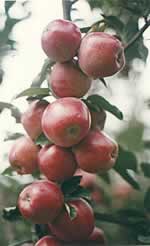 Horticulture
plays an important role in the economic life and prosperity of
the people of Kullu. During the last three decades, Kullu has
made tremendous progress in the field of Horticulture. Greater
emphasis is being laid on this sector because the geographical
features and climatic conditions prevailing in the district are
ideally suited for fruit farming.
Horticulture
plays an important role in the economic life and prosperity of
the people of Kullu. During the last three decades, Kullu has
made tremendous progress in the field of Horticulture. Greater
emphasis is being laid on this sector because the geographical
features and climatic conditions prevailing in the district are
ideally suited for fruit farming.
Among all the fruits grown in Kullu, apples are most widely grown
and represent commercially the most important fruit crop. The
cultivated apple area is 18,524 hectares. The annual apple production
usually lies between 80,000 to 90,000 metric tons. This represents
about 9,000 truck loads of apples every year.
Apart from apples other varieties of fruits grown in Kullu are
plum, peach, apricot, pomegranates and kiwi as well as nuts, especially
almonds. These fruit plantations cover an area of 3065 hectares
and and the annual production is approximately 20,000 metric tonnes.
The following table shows the plantation area of different fruits
in Kullu district as well as their harvesting season.
| Fruit |
Area (ha) |
Season |
| Apple (Standard) |
18524 |
Jul - Oct |
| Apple (Spur) |
767 |
Jul - Oct |
| Plum |
893 |
Jun |
| Pears |
400 |
Jul
- Aug |
| Apricot |
190 |
Jun - Jul |
| Kiwi |
25 |
Jul |
| Almonds |
368 |
Jul - Aug |
Status of Horticulture in Kullu District
India being a tropical country has few regions with a moderate
climate. The hilly regions along the Himalayas like Himachal Pradesh,
Jammu and Kashmir profit from this situation and have proven beneficial
for fruit growers. Apples fetched a good price in the past, especially
the variety 'Red Delicious' which appealed to the Indian masses
as they were obsessed by its bright red color.
The farmers prefered to grow this variety mainly for economic
reasons and consequently other varieties like Granny Smith, Golden,
Wynter etc. served more and more as polanizers resulting in great
yield of apples year after year.
Things started changing in the 1970's and 80's as people cut
down excessively older apple plantations and started growing 'Red'
and 'Royal Delicious' varieties. The cutting down of older trees
resulted in vast stretches of 'Royal Delicious' but the new variety
failed to produce apples in the wake of adequate pollen source.
Wreckless spraying of insecticides killed bees and other polanizing
agents, further worsening the problem.
Rising temperatures and decreasing forest areas shortened the
chilling hours required by the apple trees during winter. This
resulted in low yields and lower qualities, especially in the
fruit growing area below 1,400 m.
Factors responsible for the low yield of apples are:
- Heavy dependence on seedling root stock.
- Lack of research work on dwarf and cloned root stock.
Other factors responsible for lower income from horticulture are:
- High cost of transportation.
- Lack of a sufficient road network to fruit growing areas.
- Manual and mule transportation resulting in heavy losses
due to breakage of boxes.
- Substandard quality of carton & packing materials.
- Lack of good cold storage and pre-cooling facilities.
- Lack of technical knowledge.
- Obsolete and outdated pesticides and insecticides.
- Lack of research work in the field of pest management.
- The unrestricted apple imports pose a threat to the lower
quality domestic varieties.
- New varieties of fruits have only been marginally introduced
in Kullu during recent years.

